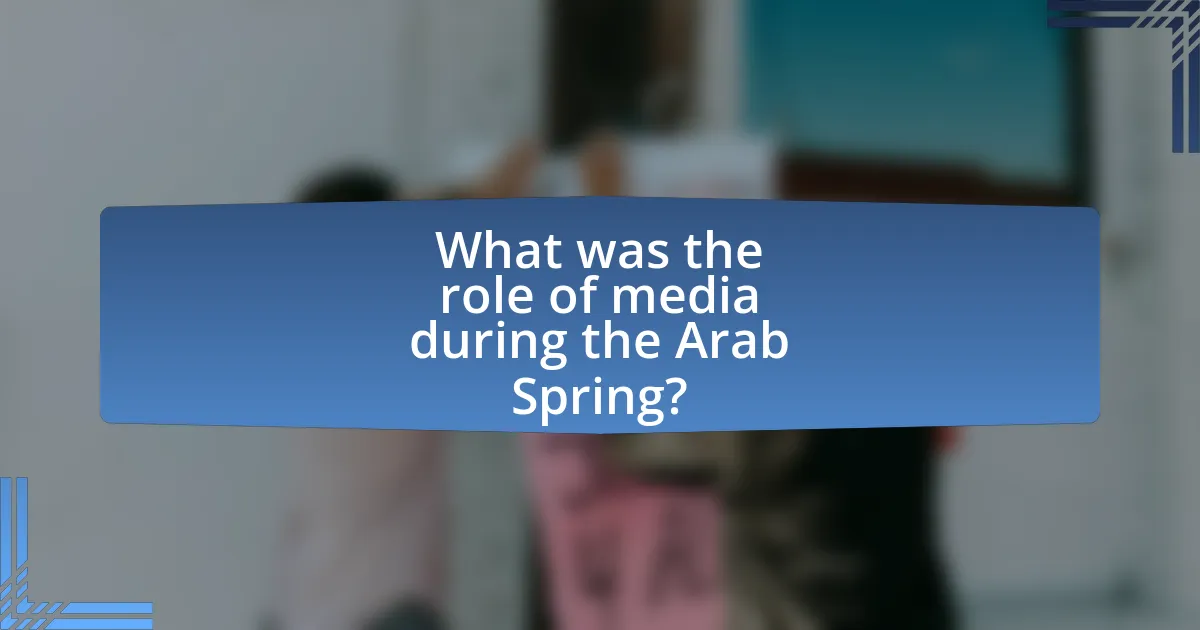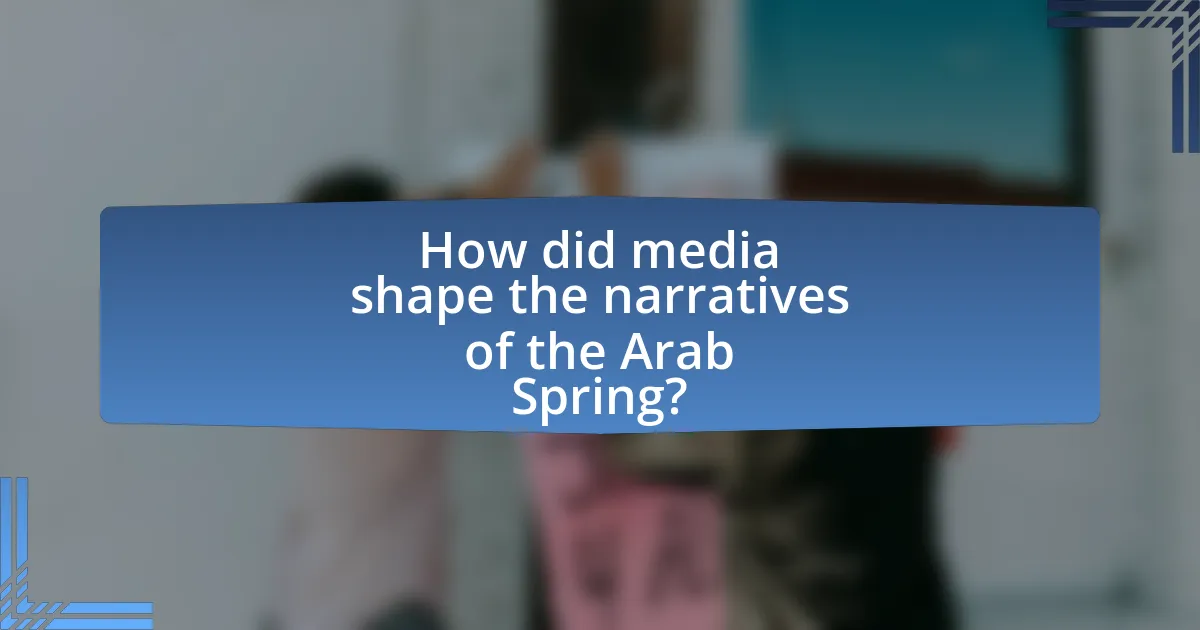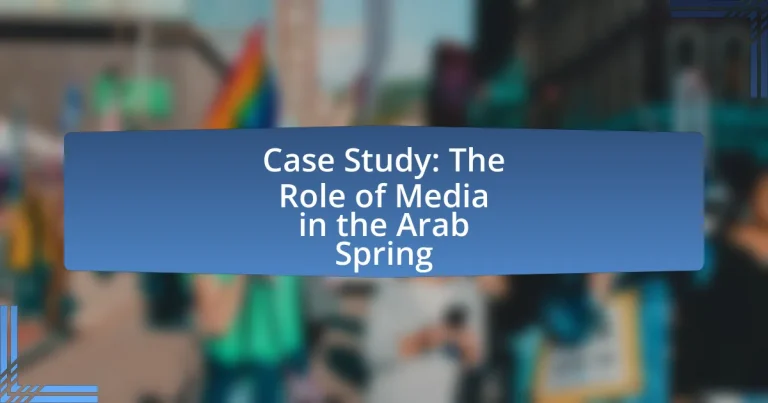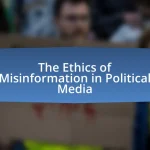The article examines the pivotal role of media during the Arab Spring, highlighting how both social and traditional media facilitated communication, mobilized protests, and shaped public perception across the region. It details the impact of platforms like Facebook and Twitter in organizing demonstrations and disseminating information, as well as the influence of traditional media outlets such as Al Jazeera in framing narratives and informing global audiences. The article also explores the variations in media coverage across different countries, the consequences of media censorship, and the lessons learned for future social movements, emphasizing the importance of media literacy and strategic communication for activists.

What was the role of media during the Arab Spring?
The media played a crucial role during the Arab Spring by facilitating communication, mobilizing protests, and shaping public perception. Social media platforms like Facebook and Twitter enabled activists to organize demonstrations, share real-time updates, and disseminate information widely, often bypassing state-controlled media. For instance, the use of hashtags such as #Jan25 in Egypt helped unify protesters and draw international attention to their cause. Additionally, traditional media outlets reported on the events, providing coverage that informed both local and global audiences about the unfolding situations in countries like Tunisia, Egypt, and Libya. This combination of social and traditional media significantly influenced the dynamics of the uprisings, highlighting the power of information in social movements.
How did traditional media influence public perception?
Traditional media significantly influenced public perception during the Arab Spring by shaping narratives and disseminating information about protests and government actions. Television networks, such as Al Jazeera, provided real-time coverage that highlighted the voices of protesters, which helped to galvanize support both locally and internationally. This coverage often contrasted with state-controlled media, which downplayed dissent and promoted government narratives. Research indicates that the visibility of protests through traditional media led to increased public awareness and engagement, as evidenced by the rapid spread of information that encouraged similar movements in neighboring countries. The role of traditional media in framing events and providing a platform for dissent was crucial in altering public perception and mobilizing collective action during this period.
What types of traditional media were most impactful?
Television and print media were the most impactful types of traditional media during the Arab Spring. Television networks, particularly Al Jazeera, played a crucial role in broadcasting live events and providing real-time updates, which significantly influenced public perception and mobilization. Print media, including newspapers, facilitated the dissemination of information and analysis, shaping the narrative around the protests. For instance, Al Jazeera’s coverage reached millions across the Arab world, highlighting the power of visual media in shaping political discourse during this period.
How did traditional media coverage vary across different countries?
Traditional media coverage during the Arab Spring varied significantly across different countries, influenced by factors such as government control, media freedom, and cultural context. In countries like Tunisia and Egypt, traditional media played a crucial role in mobilizing protests and disseminating information, often facing censorship and government pushback. For instance, in Egypt, state-controlled media initially downplayed the protests, while independent outlets provided more accurate coverage, leading to a struggle for narrative control. Conversely, in countries like Libya and Syria, traditional media faced severe restrictions, with state-run channels dominating the narrative and independent journalists facing threats and violence. This disparity in media coverage reflected the varying degrees of press freedom and governmental influence across the region during the Arab Spring.
What role did social media play in the Arab Spring?
Social media played a crucial role in the Arab Spring by facilitating communication, mobilization, and the dissemination of information among protesters. Platforms like Facebook and Twitter enabled activists to organize demonstrations, share real-time updates, and broadcast their messages to a global audience, which helped to amplify their causes. For instance, the use of Facebook to organize the January 25, 2011, protests in Egypt was pivotal, as it allowed thousands to coordinate and participate in the uprising against President Hosni Mubarak. Additionally, social media served as a tool for documenting human rights abuses, which garnered international attention and support for the movements. The rapid spread of information through these platforms significantly contributed to the momentum and visibility of the protests across various countries in the region.
How did social media facilitate communication among protesters?
Social media facilitated communication among protesters by providing real-time platforms for information sharing and coordination. During the Arab Spring, platforms like Facebook and Twitter enabled activists to organize protests, disseminate news, and mobilize support quickly. For instance, in Egypt, social media was instrumental in the organization of the Tahrir Square protests, where activists used these platforms to communicate strategies and updates, leading to mass mobilization. The ability to bypass traditional media channels allowed protesters to share their narratives directly, fostering a sense of community and urgency that was crucial for the movement’s momentum.
What platforms were most widely used during the protests?
Social media platforms, particularly Facebook and Twitter, were the most widely used during the protests of the Arab Spring. These platforms facilitated the organization of protests, dissemination of information, and mobilization of support among activists. For instance, Facebook was instrumental in the coordination of protests in Egypt, where the “We Are All Khaled Said” page played a crucial role in rallying support against the government. Additionally, Twitter served as a real-time communication tool, allowing users to share updates and connect with a global audience, which amplified the reach and impact of the protests.
Why was media coverage crucial for the success of the Arab Spring?
Media coverage was crucial for the success of the Arab Spring because it amplified the voices of protesters and facilitated the rapid dissemination of information. The extensive use of social media platforms like Twitter and Facebook allowed activists to organize demonstrations, share real-time updates, and mobilize support both locally and internationally. For instance, the viral spread of videos depicting police brutality in Tunisia sparked widespread outrage and inspired similar uprisings across the region. Additionally, international media coverage brought global attention to the movements, increasing pressure on authoritarian regimes and garnering support from foreign governments and organizations. This combination of grassroots mobilization and global awareness significantly contributed to the effectiveness and momentum of the Arab Spring protests.
How did media coverage affect international response to the uprisings?
Media coverage significantly influenced international responses to the uprisings by shaping perceptions and mobilizing global attention. The extensive reporting on protests, violence, and human rights abuses in countries like Tunisia and Egypt prompted foreign governments and organizations to take action, such as imposing sanctions or calling for intervention. For instance, the graphic images and live broadcasts of the uprisings led to widespread outrage and solidarity movements, which pressured international leaders to respond more decisively. The United Nations and various NGOs cited media coverage as a catalyst for their involvement, highlighting the role of platforms like Al Jazeera in disseminating information that galvanized international support for the protesters.
What were the consequences of media censorship during the Arab Spring?
Media censorship during the Arab Spring led to significant consequences, including the suppression of dissent, the distortion of public perception, and the escalation of protests. Governments utilized censorship to control narratives, limiting access to information about protests and government actions, which hindered citizens’ ability to organize and mobilize effectively. For instance, in Egypt, the government shut down internet access and blocked social media platforms, which resulted in a fragmented communication landscape among activists. This censorship not only fueled frustration among the populace but also contributed to the rapid spread of misinformation, as alternative narratives emerged through unofficial channels. The consequences of such censorship ultimately intensified the urgency of protests, as citizens sought to reclaim their voices and demand accountability from their governments.

How did media shape the narratives of the Arab Spring?
Media significantly shaped the narratives of the Arab Spring by providing a platform for real-time information dissemination and facilitating grassroots mobilization. Social media platforms like Twitter and Facebook enabled activists to share their experiences and organize protests, which helped to amplify the voices of dissent against authoritarian regimes. For instance, the use of hashtags such as #Jan25 during the Egyptian revolution allowed for widespread awareness and engagement, leading to mass protests that ultimately contributed to the ousting of President Hosni Mubarak. Additionally, traditional media outlets reported on the events, framing the narratives in ways that influenced public perception both locally and internationally, highlighting the struggle for democracy and human rights in the region. This interplay between social media and traditional media created a dynamic environment where narratives were continuously shaped and reshaped, reflecting the evolving political landscape during the Arab Spring.
What narratives emerged from media coverage of the protests?
Media coverage of the protests during the Arab Spring primarily highlighted narratives of grassroots activism, government repression, and the quest for democracy. Reports emphasized the role of social media in mobilizing citizens and disseminating information, showcasing how platforms like Twitter and Facebook facilitated organization and solidarity among protesters. Additionally, coverage often depicted the stark contrast between peaceful demonstrators and violent state responses, illustrating the struggle for human rights and political reform. This narrative was supported by numerous eyewitness accounts and video evidence shared online, which underscored the urgency and legitimacy of the protesters’ demands for change.
How did different media outlets portray the motivations of protesters?
Different media outlets portrayed the motivations of protesters during the Arab Spring as a mix of demands for political reform, social justice, and economic opportunities. For instance, Western media often emphasized the desire for democracy and human rights, highlighting the protesters’ calls for an end to authoritarian regimes. In contrast, some regional outlets focused on the socio-economic grievances, such as unemployment and corruption, framing the protests as a response to economic hardship. This divergence in portrayal reflects the varying editorial perspectives and political contexts of the media outlets, influencing public perception of the protests’ underlying motivations.
What impact did these narratives have on public opinion?
The narratives surrounding the Arab Spring significantly shaped public opinion by fostering a sense of solidarity and urgency for political change. These narratives, disseminated through social media and traditional news outlets, highlighted the struggles and aspirations of protesters, which resonated with both local and global audiences. For instance, the widespread sharing of images and stories from Tunisia and Egypt galvanized support for uprisings, leading to increased public engagement and participation in protests. Research conducted by the Pew Research Center in 2011 indicated that social media played a crucial role in mobilizing youth and shaping perceptions about the legitimacy of the protests, demonstrating a direct correlation between media narratives and shifts in public sentiment.
How did the portrayal of leaders and regimes evolve in the media?
The portrayal of leaders and regimes in the media evolved significantly during the Arab Spring, transitioning from glorified representations to critical scrutiny. Initially, state-controlled media often depicted leaders as heroic figures, emphasizing their achievements and stability. However, as social media emerged and gained traction, citizens began to share real-time accounts of protests and government repression, leading to a shift in narrative. For instance, the widespread use of platforms like Twitter and Facebook allowed for the dissemination of uncensored information, challenging the official narratives and exposing human rights abuses. This shift was evident in countries like Egypt and Tunisia, where media coverage transitioned from state propaganda to highlighting grassroots movements and calls for democratic reforms. The evolution reflects a broader trend of increasing media democratization, where traditional media’s role diminished in favor of citizen journalism, fundamentally altering public perception of authority figures and regimes.
What strategies did regimes use to counter negative media coverage?
Regimes countered negative media coverage during the Arab Spring through censorship, propaganda, and the use of social media manipulation. Censorship involved blocking access to critical news outlets and restricting journalists’ activities, as seen in countries like Egypt, where the government shut down independent media and arrested reporters. Propaganda was employed to promote a favorable narrative, often through state-controlled media that highlighted government achievements while downplaying dissent. Additionally, regimes utilized social media to spread disinformation and create a false sense of public support, exemplified by the use of bots and fake accounts to amplify pro-government messages. These strategies collectively aimed to undermine the impact of negative coverage and maintain control over public perception.
How did media framing influence the perception of legitimacy among leaders?
Media framing significantly influenced the perception of legitimacy among leaders during the Arab Spring by shaping public narratives and opinions. For instance, the portrayal of protests as either legitimate expressions of popular dissent or as violent uprisings directly affected how leaders were viewed by both domestic and international audiences. Research by the Pew Research Center indicated that media coverage emphasizing the voices of protesters contributed to a perception of legitimacy for opposition movements, while framing government responses as oppressive diminished the legitimacy of those in power. This dynamic was evident in countries like Egypt and Tunisia, where media framing played a crucial role in mobilizing public support against established regimes, ultimately leading to their downfall.
What lessons can be learned from the media’s role in the Arab Spring?
The media’s role in the Arab Spring demonstrates the critical importance of information dissemination in social movements. During the Arab Spring, platforms like Twitter and Facebook facilitated real-time communication, enabling activists to organize protests and share their experiences globally. For instance, in Tunisia, social media played a pivotal role in mobilizing citizens against the regime, leading to the ousting of President Ben Ali in January 2011. This illustrates that media can empower grassroots movements by providing a voice to the marginalized and fostering solidarity among diverse groups. Furthermore, the Arab Spring highlighted the dual nature of media; while it can serve as a tool for liberation, it can also be manipulated by governments to spread propaganda or misinformation. This underscores the necessity for media literacy among citizens to critically evaluate information sources.
What best practices can be identified for future movements?
Best practices for future movements include leveraging social media for real-time communication and mobilization, as demonstrated during the Arab Spring where platforms like Twitter and Facebook facilitated rapid organization and information dissemination. Additionally, establishing clear goals and narratives is crucial; movements that articulated specific demands, such as those seen in Tunisia, garnered broader support and legitimacy. Furthermore, maintaining adaptability in strategies allows movements to respond effectively to changing political landscapes, as evidenced by the varied approaches taken across different countries during the Arab Spring. Lastly, fostering coalitions among diverse groups enhances resilience and resource sharing, which was pivotal in sustaining momentum throughout the protests.
How can activists effectively utilize media in their campaigns?
Activists can effectively utilize media in their campaigns by leveraging social media platforms to disseminate information rapidly and engage with a broader audience. During the Arab Spring, platforms like Twitter and Facebook played crucial roles in organizing protests, sharing real-time updates, and mobilizing support, demonstrating the power of digital communication in grassroots movements. Research by the Berkman Klein Center for Internet & Society at Harvard University highlights that social media not only facilitated the spread of information but also helped in building networks among activists, which was essential for the coordination of large-scale demonstrations.
What are the risks associated with media reliance in social movements?
The risks associated with media reliance in social movements include misinformation, loss of control over narratives, and potential backlash from authorities. Misinformation can spread rapidly through social media platforms, leading to confusion and undermining the credibility of the movement, as seen during the Arab Spring when false reports sometimes incited violence. Additionally, reliance on media can result in activists losing control over the narrative, as external actors may manipulate coverage to serve their interests, which occurred when various factions attempted to shape the portrayal of events in Egypt and Libya. Finally, increased visibility through media can provoke harsh responses from governments, leading to crackdowns on protests and activists, evidenced by the violent reprisals faced by demonstrators in Bahrain after their actions gained international attention.
How can media literacy improve the effectiveness of future protests?
Media literacy can improve the effectiveness of future protests by equipping participants with the skills to critically analyze information and discern credible sources from misinformation. This capability enables protesters to effectively communicate their messages, mobilize support, and counteract false narratives that may undermine their cause. For instance, during the Arab Spring, social media played a crucial role in organizing protests, but misinformation also spread rapidly, leading to confusion and division among activists. By fostering media literacy, future protest movements can enhance their strategic communication, ensuring that accurate information circulates and resonates with broader audiences, ultimately increasing their impact and effectiveness.
What skills are essential for activists to navigate media landscapes?
Activists must possess strong communication, digital literacy, and critical thinking skills to effectively navigate media landscapes. Communication skills enable activists to articulate their messages clearly and engage diverse audiences, which is crucial for mobilizing support. Digital literacy allows activists to utilize various online platforms for outreach, information dissemination, and community building, as seen during the Arab Spring when social media played a pivotal role in organizing protests. Critical thinking skills help activists analyze media narratives, discern misinformation, and adapt their strategies accordingly, ensuring their messages resonate and maintain credibility in a rapidly changing media environment.
How can communities build resilience against misinformation?
Communities can build resilience against misinformation by fostering media literacy and encouraging critical thinking among their members. By implementing educational programs that teach individuals how to evaluate sources, discern fact from opinion, and recognize biases, communities empower their members to navigate information more effectively. Research indicates that media literacy initiatives can significantly reduce the susceptibility to misinformation; for instance, a study published in the Journal of Media Literacy Education found that participants who underwent media literacy training were 30% more likely to identify false information accurately. Additionally, creating platforms for open dialogue and discussion allows community members to share insights and verify information collectively, further strengthening their ability to resist misinformation.


